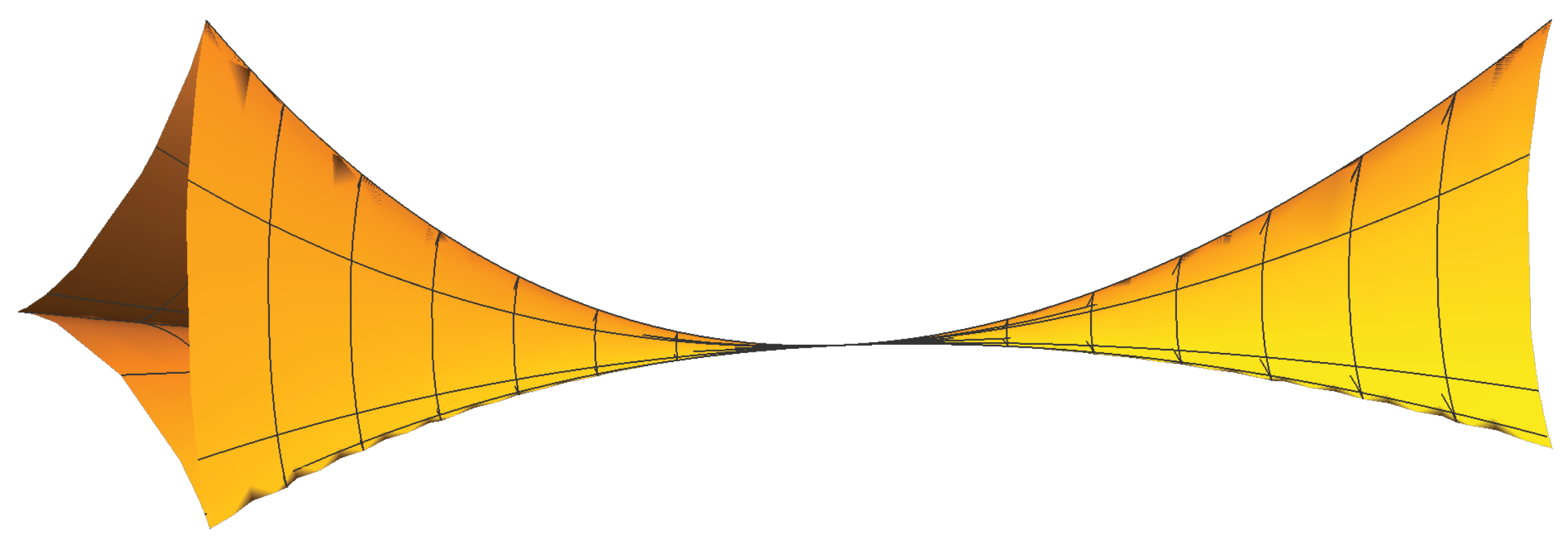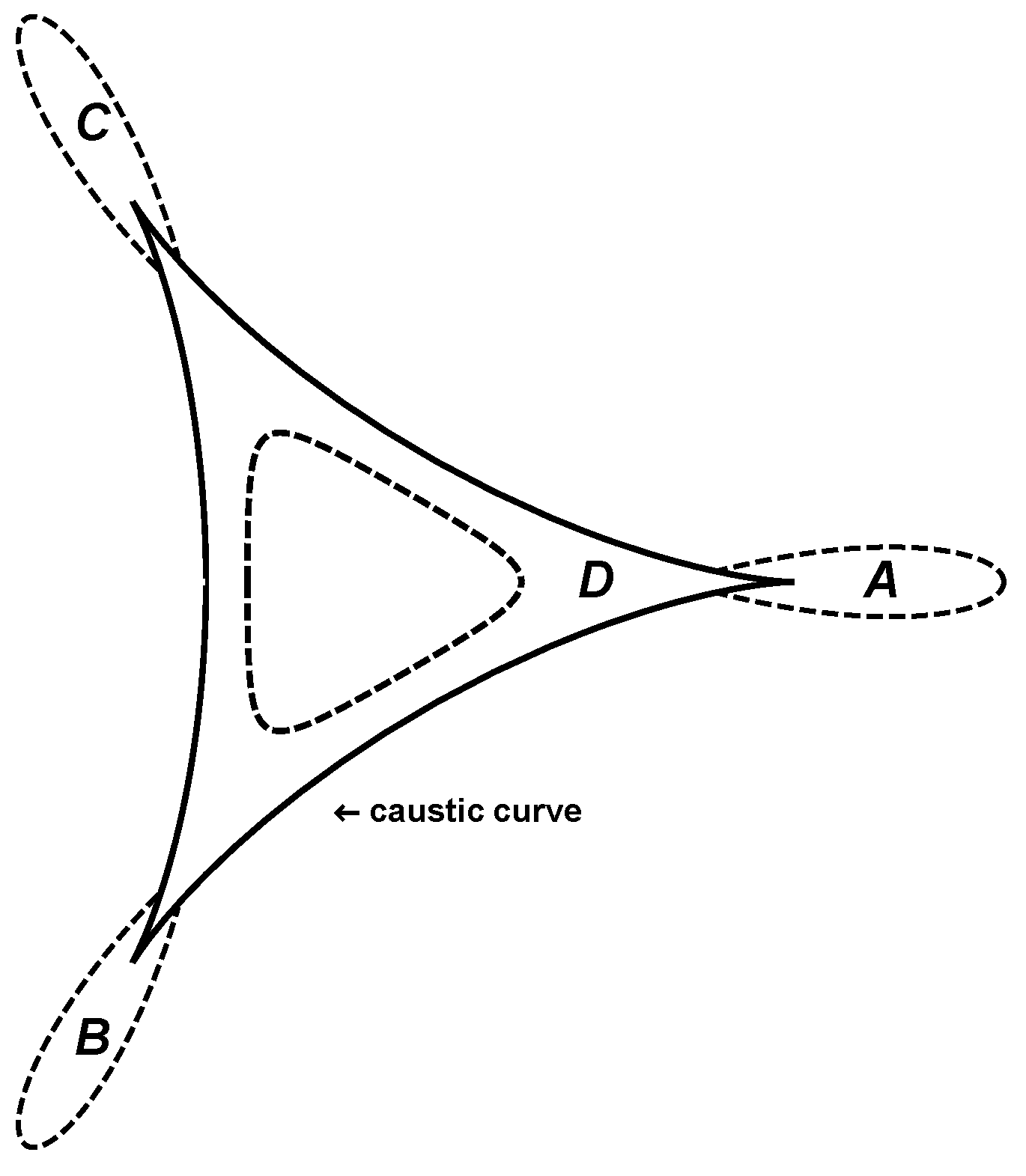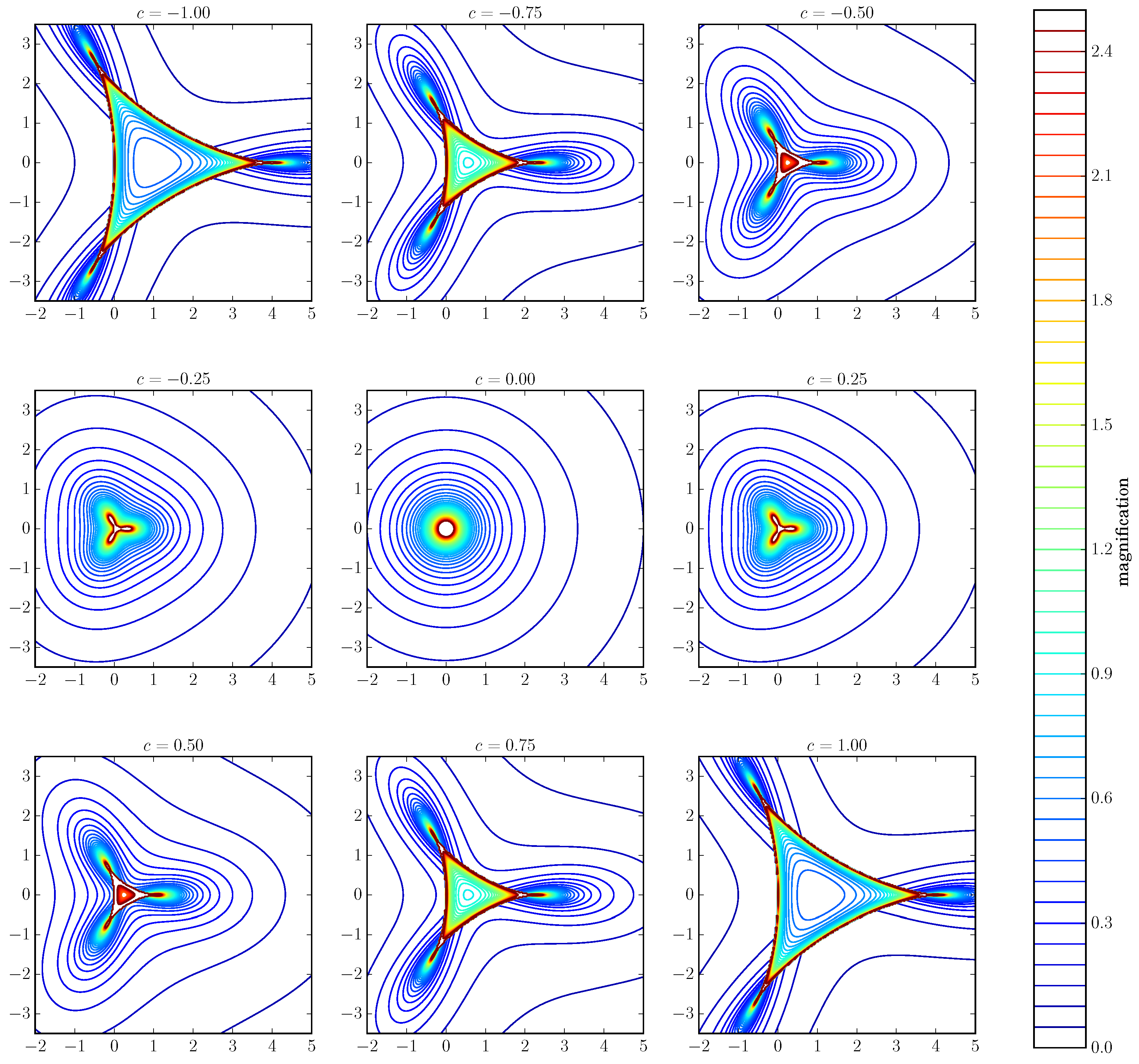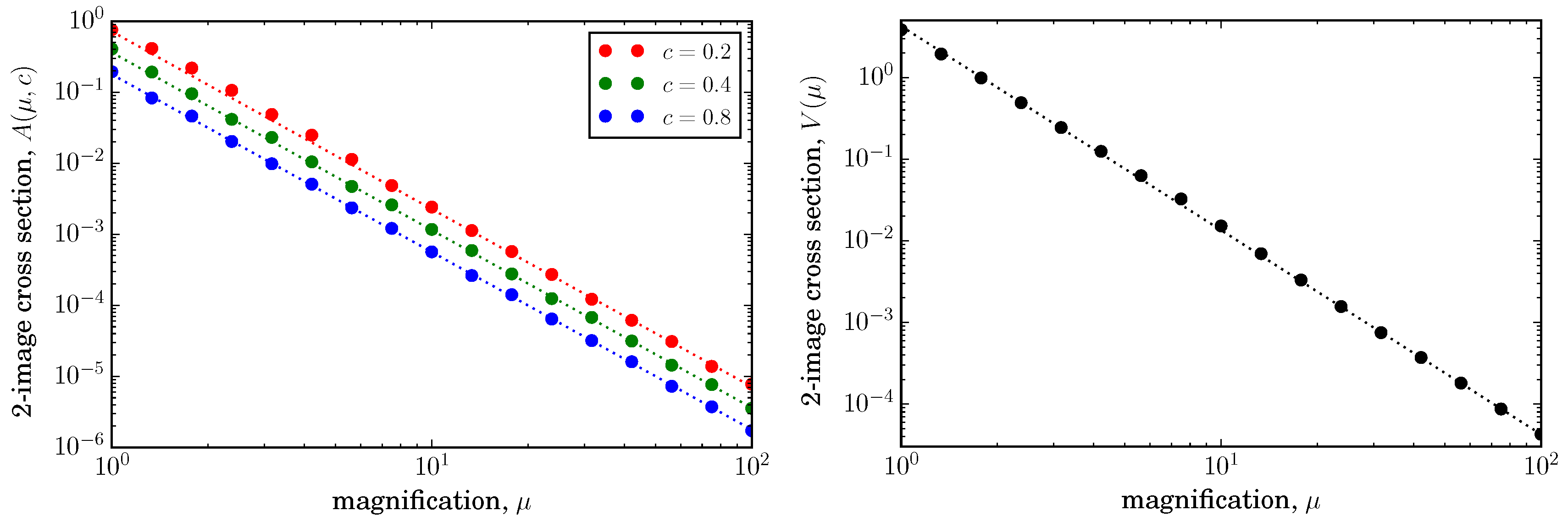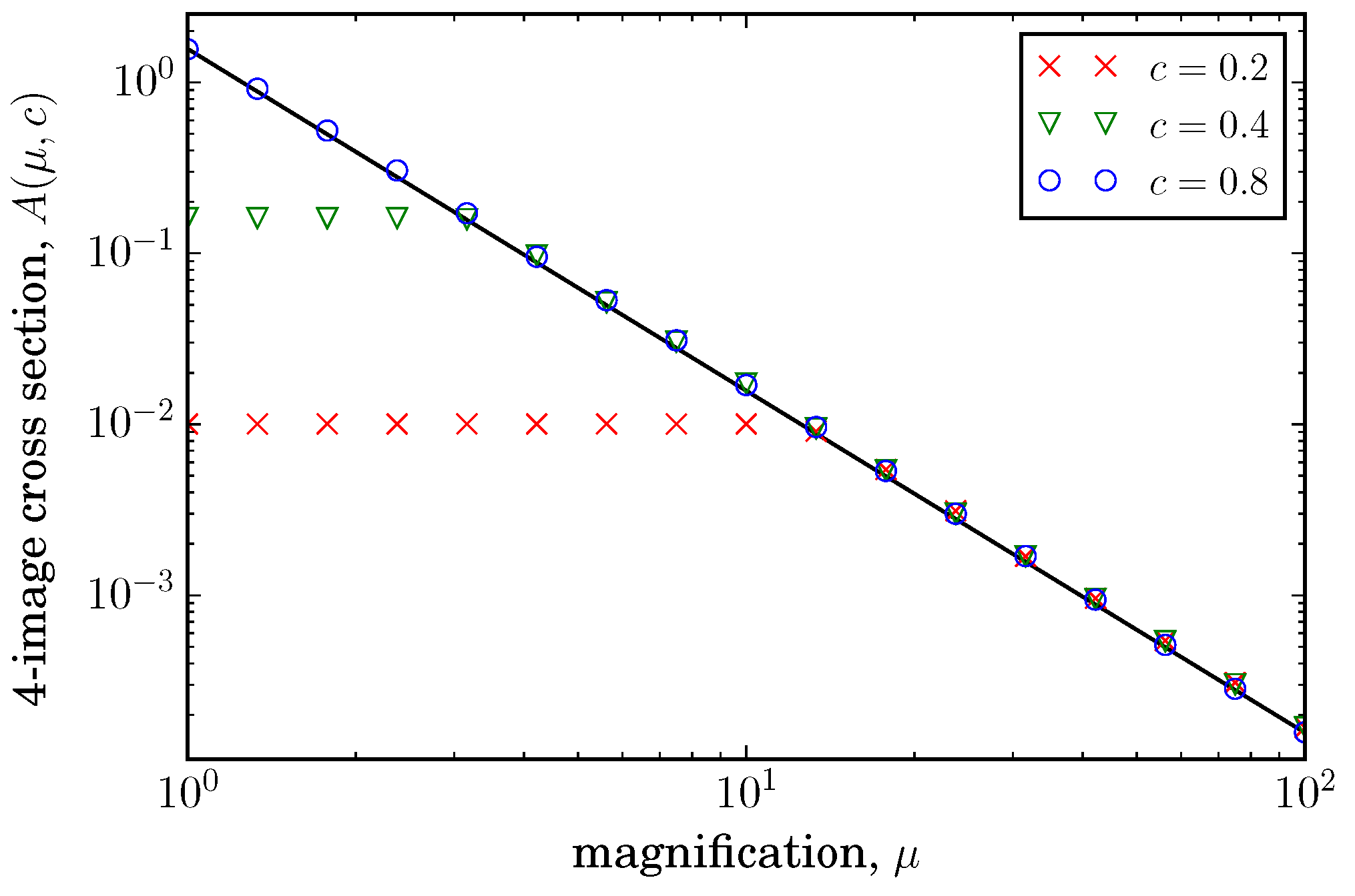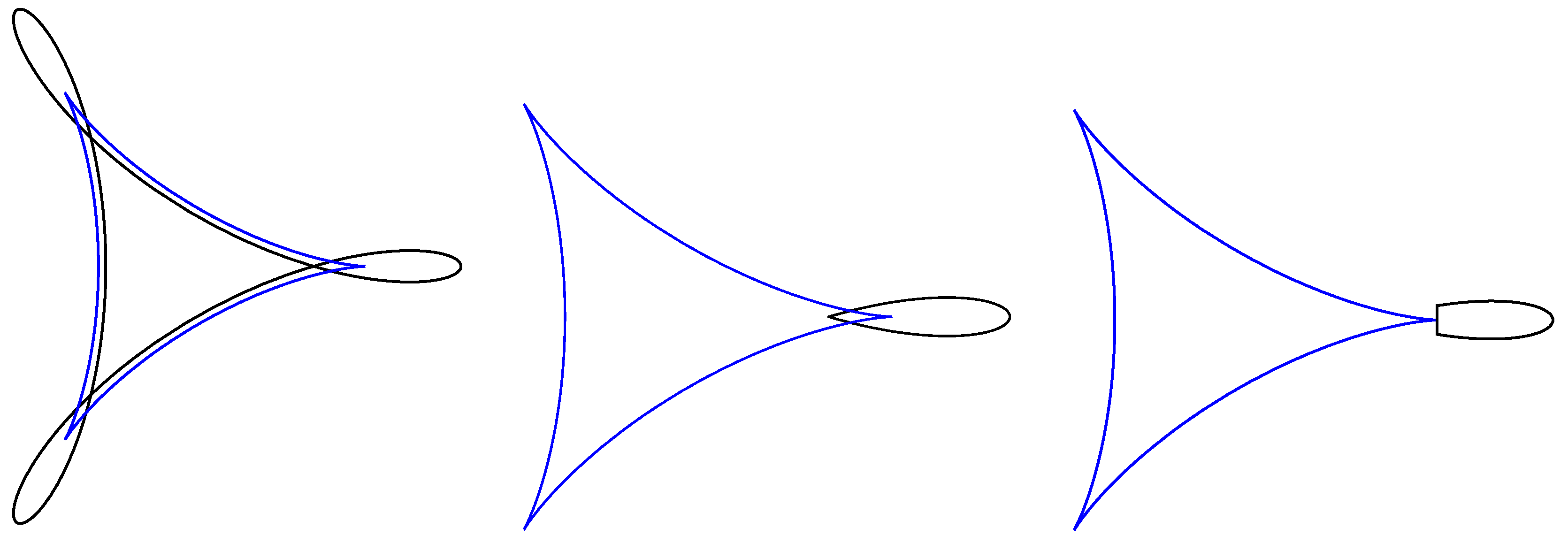1. Introduction
Magnification cross sections are an important tool in gravitational lensing. Knowing the magnification cross section allows one to determine the probability that a light source will have magnification greater than some fixed value. This in turn gives information about the accuracy of cosmological models, since these predict different probabilities regarding source magnifications (see Schneider et al. 1992 [
1], Kaiser 1992 [
2], Bartelmann et al. 1998 [
3], and Petters et al. 2001 ([
4] Chapter 13)). Knowing magnification cross sections is also important for observational programs that use lensing magnification to help detect extremely faint galaxies (see, e.g., Lotz et al. 2017 [
5], and references therein).
It is well known that for the so-called “fold” and “cusp” caustic singularities, the area cross sections scale asymptotically as
and
, respectively, where
is the total unsigned magnification of a lensed source (for the cusp caustic, it is assumed that the source lies in the one-image region locally). In the case of single-plane lensing, the fold scaling was determined by Blandford and Narayan 1986 [
6], while the cusp scaling was determined by Mao 1992 [
7] and Schneider and Weiss 1992 [
8]. For multiple-plane lensing, the fold and cusp scalings were determined by Petters et al. ([
4] Chapter 13).
In this paper we commence the study of magnification cross sections of “higher-order” caustic surfaces; in particular, we derive the (single-plane) asymptotic limit of the magnification cross section for the “elliptic umbilic” caustic surface, which is not a curve but rather a two-dimensional stable caustic surface in a three-dimensional parameter space (for precise definitions, consult, e.g., Arnold 1973 [
9], Callahan 1974 & 1977 [
10,
11], Majthay 1985 [
12], Arnold et al. 1985 [
13], Petters 1993 [
1,
4,
14]); its magnification “cross section” is therefore a region with volume. As hypothesized in Rusin et al. 2001 [
15] and Blandford 2001 [
16], the elliptic umbilic is likely to be manifested inside a triangle formed by three lensing galaxies, and to involve one positive-parity and three negative-parity images. As shown in Shin and Evans 2008 [
17] and de Xivry and Marshall 2009 [
18], elliptic umbilics can also appear in lensing by binary galaxies, if the binary separation is small enough. The asymptotic scaling of the elliptic umbilic volume cross section will depend on whether the source gives rise to two or four lensed images locally. We show that, in the two-image region, this volume cross section scales to leading order as
, whereas in the four-image region, its leading order scales as
. In both cases, our results are supported numerically and analytically. In our derivation of
in the four-image region, we make use of a certain magnification relation that holds for higher-order caustic singularities, and the elliptic umbilic in particular, that was shown to hold in Aazami and Petters 2009 [
19].
2. The Elliptic Umbilic Caustic Surface
Let
denote coordinates on the lens plane and
coordinates on the source plane. Like all higher-order caustic surfaces, the “elliptic umbilic caustic” has parameters in addition to the two source plane coordinates. (Such higher-order parameters can, depending on the setting, be used to model the source redshift, radii of galaxies, ellipticities, distance along the line of sight, etc., of the lens system in question; see, e.g., ([
1] Chapter 8)). A gravitational lensing map in the neighborhood of an elliptic umbilic critical point, as derived in ([
1] Chapter 5), takes the form
where
is a parameter in addition to the source plane coordinates
; i.e., the elliptic umbilic caustic is a surface in the parameter space
, not a curve in the source plane
. Accordingly, the “magnification cross section" is a (three-dimensional) volume, and the asymptotic scaling is the leading order term in the limit as the magnification goes to infinity.
Figure 1 shows the elliptic umbilic caustic surface, while
Figure 2 shows a
c-slice of it on the source plane
S.
If a source located at
on the source plane has a lensed image located at
on the lens plane, then the magnification
of this lensed image is given by
Now fix
and
. Consider first the four-image region enclosed by the caustic curve in
Figure 2. Let
denote the subset consisting of those source positions
in the four-image region with total unsigned magnification equal to
, where the unsigned magnification of each image
belonging to
is given by
in Equation (
2).
will consist of the closed dashed curve inside the caustic curve in
Figure 2; any source inside the dashed region will have total unsigned magnification less than
, while a source in the region
D will have total unsigned magnification equal to
. Likewise for the two-image region, which is the (unbounded) region outside the caustic curve: For
large enough, the enclosed regions
A,
B, and
C comprise those sources whose two lensed images will have total unsigned magnification greater than
. (By symmetry,
A,
B, and
C all have the same areas).
Whether in the two- or the four-image region, the asymptotic scaling there is determined as follows. The areas labeled
A,
B,
C, and
D will in general be functions of
and
c; denote any one of these, e.g., by
. To obtain a volume section, denoted
, we integrate
where
are arbitrary but of the same sign. Finally, we take the limit
and identify the leading order term; this is the asymptotic scaling of the elliptic umbilic magnification volume.
We first examine the scalings numerically. For a given
c-slice, we compute the total magnification on a grid in plane
S, as shown in
Figure 3. The grid is adaptive, meaning that more grid points are used in regions where the magnification changes quickly and high resolution is needed to obtain accurate results. We use the grid to approximate the area integral and compute
. We then combine different
c-slices to approximate the integral in Equation (
3) and obtain
.
Figure 4 shows examples of
and
for the two-image region, while
Figure 5 shows
for the four-image region.
We support our numerical findings with the following analytical arguments. For the four-image region, there is in fact a succinct argument that confirms the numerical result
, as follows. For any source in the four-image region (and assuming
), the lensing map of Equation (
1) has three lensed images with negative magnification and one lensed image with positive magnification, where the magnification of a lensed image is given by Equation (
2). Fix
and let
denote the set of sources in the four-image region whose one positive-magnification image has magnification
; as usual, let
denote the total unsigned magnification of this source. In fact
comprises the closed dashed curve inside the caustic that we saw in
Figure 2. It is straightforward to compute that the area labeled
D — that is, the area outside
but inside the caustic — is equal to
Observe that this area is
c-independent. This area is related to
, the magnification (area) cross section, as follows. Let
be a source in the four-image region whose total unsigned magnification is
. Clearly
, since its one positive-magnification image must be less than
. However, it is known that the four-image region of the elliptic umbilic, for any
, satisfies the following magnification relation.
where
is the signed magnification of lensed image
i; see [
19] for a proof. (For clarity, we use the notation “
” to denote the magnification belonging to an individual image, and reserve the notation “
” to denote the total unsigned magnification of a source). It follows that
, because the positive-magnification image must have magnification
, since the other three magnifications are negative and must cancel it out. Thus, the closed curve
is precisely the level curve of sources with total unsigned magnification
. Observe that when
in Equation (
4), then
, as in
Figure 5. And thus the area cross section scales like Equation (
4).
Figure 5 confirms this result numerically. Integrating Equation (
4) from
to
yields a volume cross section that clearly scales as
.
There remains, finally, the two-image region outside the caustic curve shown in
Figure 2. Here, for
large enough, those sources with total unsigned magnification greater than
comprise the regions labeled
A,
B, and
C, which three enclosed areas are equal by symmetry. In this case the area enclosed by them is not as easily derivable analytically, due to the complicated nature of the intersection points of the dashed curves with the caustic. However, it is possible to bound the areas
A,
B, and
C, from above and below, and to show that these lower and upper bounds, which are functions of
and
c, both scale to leading order in
as
, thereby supporting our numerical results in
Figure 4.
Figure 6 briefly describes the procedure, foregoing technical details.
